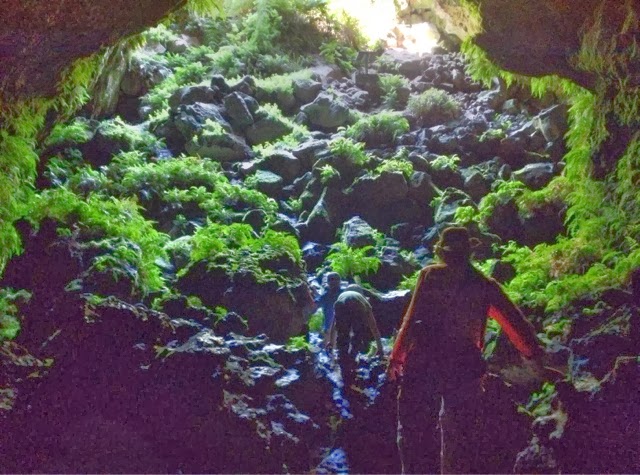Our camp at Lake Elingamite
We explored further and visited Mount Leura near Camperdown. A classic cone and maar system, it also had fantastic views across the surrounding plains. Some of the lakes were simply beautiful, however most are on private property and you cannot access them.
We explored further and visited Mount Leura near Camperdown. A classic cone and maar system, it also had fantastic views across the surrounding plains. Some of the lakes were simply beautiful, however most are on private property and you cannot access them.
Mum and the Little Helper look towards Mount Elephant (also known as The Swagman's Lighthouse)
We returned to the coast, for a night at Warrnambool. We took the opportunity to visit the Flagstaff Hill maritime museum, the highlight being the Loch Ard Peacock. The museum had an excellent activity book for the kids, and we explored the museum looking for clues for the Sea Chest Scavenger Hunt. It was well done and was a good addition to the schooling 'evidence' file!
The view was almost a full 360 degrees
We enjoyed a morning tea on our 'deck' aka roof rack
We returned to the coast, for a night at Warrnambool. We took the opportunity to visit the Flagstaff Hill maritime museum, the highlight being the Loch Ard Peacock. The museum had an excellent activity book for the kids, and we explored the museum looking for clues for the Sea Chest Scavenger Hunt. It was well done and was a good addition to the schooling 'evidence' file!
The Flagstaff Hill museum is part theme village, and is an excellent glimpse into an old port town.
One last explore of the fantastic kids playground at Warrnambool, batteries fully charged (all of them), collection of the last load of washing off the line and water tanks filled to capacity, we were ready to head bush again.
The recent lava flows in the area, from as recent as six thousand years ago, have formed a layer of basalt on top of the limestone bedrock. We had no Idea there are lava tubes here to explore, but there are, so we made our way to the Byaduk Caves.
These caves so young and un-weathered inside it looks as though the basalt was poured only a week or two ago.
The Sailmaker's loft was beautifully put together.
One last explore of the fantastic kids playground at Warrnambool, batteries fully charged (all of them), collection of the last load of washing off the line and water tanks filled to capacity, we were ready to head bush again.
The recent lava flows in the area, from as recent as six thousand years ago, have formed a layer of basalt on top of the limestone bedrock. We had no Idea there are lava tubes here to explore, but there are, so we made our way to the Byaduk Caves.
These caves so young and un-weathered inside it looks as though the basalt was poured only a week or two ago.
It was also the quietest the Little Fisherman had been all week. The sign outside warned about making loud noises, and some of the rocks on the roof cavity looked to be hanging precariously. It was bliss :)
Whilst the poor iPhone camera couldn't possibly capture the beauty of the caves, we enjoyed a bit of respite in the cool, whilst also taking care to try not to damage any of the rare ferns and mosses growing near the collapsed cave roof.
With an abundance of basalt, many farm fences were made of dry stone walls - and the majority are in remarkably good condition, some 150 years on.
Unfortunately we were kept up for a while with fishing boats coming and going, but that all stopped once it got dark.
Glenelg River
Glenelg RiverWe got up the following morning and were on the road 25 minutes after getting out of bed. No real reason other than we had promised the boys a bakery brekky in Mount Gambia. Funny how boys are motivated by food. Yes, we were heading to see another of the famous lakes of Australia - and one with a unique talent - but our whole day was going to be full of wonderful surprises before it was to be done with us.














No comments:
Post a Comment